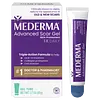What's inside
What's inside
 Key Ingredients
Key Ingredients

 Benefits
Benefits

 Concerns
Concerns

 Ingredients Side-by-side
Ingredients Side-by-side

Dimethicone 2%
EmollientWater
Skin ConditioningCetearyl Alcohol
EmollientPentylene Glycol
Skin ConditioningC12-15 Alkyl Benzoate
AntimicrobialDicaprylyl Carbonate
EmollientGlycerin
HumectantArachidyl Alcohol
EmollientAlcohol
AntimicrobialAloe Barbadensis Leaf Juice
Skin ConditioningCyclopentasiloxane
EmollientBehenyl Alcohol
EmollientCyclohexasiloxane
EmollientArachidyl Glucoside
EmulsifyingAllium Cepa Bulb Extract
Skin ConditioningParfum
MaskingCetearyl Glucoside
EmulsifyingTocopheryl Acetate
AntioxidantHydroxyethyl Acrylate/Sodium Acryloyldimethyl Taurate Copolymer
Emulsion StabilisingHydroxyethylcellulose
Emulsion StabilisingGlycine
BufferingPanthenol
Skin ConditioningHydrolyzed Collagen
EmollientPEG-400
Emulsion StabilisingPolysorbate 60
EmulsifyingSorbitan Isostearate
EmulsifyingCitric Acid
BufferingSodium Hydroxide
BufferingAlanine
MaskingArginine Hcl
Skin ConditioningAspartic Acid
MaskingGlucose
HumectantGlutamic Acid
HumectantIsopropyl Alcohol
SolventLeucine
Skin ConditioningLysine Hcl
Skin ConditioningMannitol
HumectantSodium Lactate
BufferingSorbitol
HumectantTromethamine
BufferingValine
MaskingPotassium Sorbate
PreservativeSodium Benzoate
MaskingTocopherol
AntioxidantBis(Tripeptide-1) Copper Acetate
Skin ConditioningHistidine
HumectantHydrolyzed Soy Protein
HumectantIsoleucine
Skin ConditioningPhenylalanine
MaskingTyrosine
MaskingDimethicone 2%, Water, Cetearyl Alcohol, Pentylene Glycol, C12-15 Alkyl Benzoate, Dicaprylyl Carbonate, Glycerin, Arachidyl Alcohol, Alcohol, Aloe Barbadensis Leaf Juice, Cyclopentasiloxane, Behenyl Alcohol, Cyclohexasiloxane, Arachidyl Glucoside, Allium Cepa Bulb Extract, Parfum, Cetearyl Glucoside, Tocopheryl Acetate, Hydroxyethyl Acrylate/Sodium Acryloyldimethyl Taurate Copolymer, Hydroxyethylcellulose, Glycine, Panthenol, Hydrolyzed Collagen, PEG-400, Polysorbate 60, Sorbitan Isostearate, Citric Acid, Sodium Hydroxide, Alanine, Arginine Hcl, Aspartic Acid, Glucose, Glutamic Acid, Isopropyl Alcohol, Leucine, Lysine Hcl, Mannitol, Sodium Lactate, Sorbitol, Tromethamine, Valine, Potassium Sorbate, Sodium Benzoate, Tocopherol, Bis(Tripeptide-1) Copper Acetate, Histidine, Hydrolyzed Soy Protein, Isoleucine, Phenylalanine, Tyrosine
Ingredients Explained
These ingredients are found in both products.
Ingredients higher up in an ingredient list are typically present in a larger amount.
Alcohol comes in many different forms. Different types of alcohol will have different effects on skin. This ingredient is usually an astringent alcohol.
These alcohols are drying on the skin. They may strip away your skin's natural oils and even damage your skin barrier. Astringent alcohols may also irritate skin.
Other types of astringent alcohols include:
According to the National Rosacea Society based in the US, you should be mindful of products with these alcohols in the top half of ingredients.
Any type of sanitizing product will have high amounts of alcohol to help kill bacteria and viruses.
Fatty alcohols come from plant oils such as coconut oil. These can help hydrate the skin and are non-irritating. Some fatty alcohols include cetyl and stearyl alcohol.
Learn more about AlcoholRed onion extract? This ingredient not only benefits our diet but also offers numerous benefits for the skin.
Like many other plant extracts, red onion is loaded with antioxidants and nutrients. The red color of the onion comes from its high anthocyanin content - and anthocyanin is a potent antioxidant.
Besides being rich in antioxidants, red onions also contain sulfur, sugars, Vitamin C, and biotin.
A study from 2018 found onion extract to be just as effective as healing surgical scars as traditional silicone gel.
Another study from 2008 showed using this ingredient helped reduce surgical scar texture, redness, and overall appearance in 60 patients.
According to a manufacturer, this ingredient can help with the following:
Another manufacturer from Spain claims onion extract can inhibit the release of allergy hormones and prostaglandin, or lipids found near tissue damage and infection spots.
This ingredient is water-soluble.
Learn more about Allium Cepa Bulb ExtractPanthenol is a common ingredient that helps hydrate and soothe the skin. It is found naturally in our skin and hair.
There are two forms of panthenol: D and L.
D-panthenol is also known as dexpanthenol. Most cosmetics use dexpanthenol or a mixture of D and L-panthenol.
Panthenol is famous due to its ability to go deeper into the skin's layers. Using this ingredient has numerous pros (and no cons):
Like hyaluronic acid, panthenol is a humectant. Humectants are able to bind and hold large amounts of water to keep skin hydrated.
This ingredient works well for wound healing. It works by increasing tissue in the wound and helps close open wounds.
Once oxidized, panthenol converts to pantothenic acid. Panthothenic acid is found in all living cells.
This ingredient is also referred to as pro-vitamin B5.
Learn more about PanthenolParfum is a catch-all term for an ingredient or more that is used to give a scent to products.
Also called "fragrance", this ingredient can be a blend of hundreds of chemicals or plant oils. This means every product with "fragrance" or "parfum" in the ingredients list is a different mixture.
For instance, Habanolide is a proprietary trade name for a specific aroma chemical. When used as a fragrance ingredient in cosmetics, most aroma chemicals fall under the broad labeling category of “FRAGRANCE” or “PARFUM” according to EU and US regulations.
The term 'parfum' or 'fragrance' is not regulated in many countries. In many cases, it is up to the brand to define this term.
For instance, many brands choose to label themselves as "fragrance-free" because they are not using synthetic fragrances. However, their products may still contain ingredients such as essential oils that are considered a fragrance by INCI standards.
One example is Calendula flower extract. Calendula is an essential oil that still imparts a scent or 'fragrance'.
Depending on the blend, the ingredients in the mixture can cause allergies and sensitivities on the skin. Some ingredients that are known EU allergens include linalool and citronellol.
Parfum can also be used to mask or cover an unpleasant scent.
The bottom line is: not all fragrances/parfum/ingredients are created equally. If you are worried about fragrances, we recommend taking a closer look at an ingredient. And of course, we always recommend speaking with a professional.
Learn more about ParfumWater. It's the most common cosmetic ingredient of all. You'll usually see it at the top of ingredient lists, meaning that it makes up the largest part of the product.
So why is it so popular? Water most often acts as a solvent - this means that it helps dissolve other ingredients into the formulation.
You'll also recognize water as that liquid we all need to stay alive. If you see this, drink a glass of water. Stay hydrated!
Learn more about Water